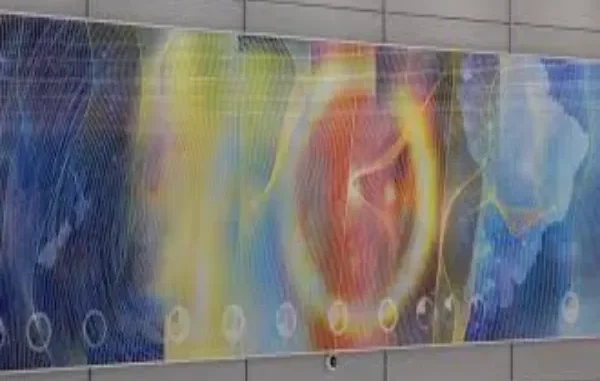

Still images are not usually sufficient to attract attention. No matter how vivid the colors or how sharp the details, posters, prints, and even advertisements may blend into the background.
In a modern world where the visuals have overwhelmed everyone, people no longer want a flat design- they want things that will surprise, attract or raise some interest. This is where the old-fashioned art and marketing tools have the greatest challenge: they are in danger of being forgotten within a few seconds.
Meanwhile, designers and brands are being pressured to be unique without making use of tricks that have a short shelf life. They desire something that is memorable, something that is not a one-second look. Even the most beautifully crafted regular visuals often fail to create that lasting impression.
Lenticular art alters this balance by bringing movement, depth and transformation onto static surfaces.
This article will look into the amazing world of the lenticular design, how it works, its artistic possibilities, and how it can be practically implemented.
What Exactly Is Lenticular Art?

Lenticular art involves a special lens that is used to blend various images on a single surface. The image seems to move, flip, or display a 3-D depth depending on the angle through which it is viewed. In comparison to regular printing, this technique converts images into a dynamic experience. Viewers do not simply look at an image, but they engage with it.
Such interactivity is what makes lenticular art more than a novelty. It turns into a storytelling tool, exposing secrets, and making one feel amazed with each change of point of view.
How Lenticular Printing Works?
It starts with interlacing—splitting several images into thin strips, and fusing them together. A lenticular lens consisting of little ridges or lenses is then overlaid onto the print. Each ridge directs the eye to different strips based on the angle of the view. The outcome is a smooth illusion of movement or depth.
As an illustration, one tilt may depict a smiling person, and another one depicts a person turning away. The effect may replicate animation with a series of images. This is an artistic and technical method that demands accuracy in alignment, resolution and lens selection.
Types of Lenticular Effects

Different effects can be created depending on how the images are prepared:
- Flip Effect – Switches between two or more images, such as before-and-after shots.
- Motion Effect – Creates the illusion of movement or animation when viewed from different angles.
- 3D Depth – Adds a sense of depth, making flat images appear three-dimensional.
- Morphing – Gradually transforms one image into another.
- Zoom – Produces the effect of an object enlarging or moving closer.
These effects allow endless creative combinations, making lenticular art versatile for both creative expression and commercial use.
Why Artists Are Turning to Lenticular?
Artists are always seeking avenues that would push the limits of perception and have an emotional impact. Lenticular art offers it in a manner that is not possible with traditional painting or even digital art. Its motion attracts spectators, making them stick their eyes in an attempt to make meaning out of the message.
Additionally, the lenticular pieces are effective in exhibitions. They encourage individuals to interact physically by walking around the workplace in order to unlock its layers. This interactivity makes art more of an experience as opposed to an observation.
Applications in Marketing and Design

The commercial value of lenticular printing is undeniable. Brands use it to make their messages more memorable. Business cards with a flip effect leave a stronger impression. Posters with animated sequences stand out in crowded environments. Packaging with 3D visuals creates curiosity that encourages purchase.
Even educational tools benefit. A lenticular diagram can show stages of a process or changes over time, making complex concepts easier to grasp. In this way, lenticular design bridges creativity with practicality.
Design Considerations for Effective Results
While the effects are captivating, success depends heavily on preparation. Designers must keep a few principles in mind:
- High-Quality Images – Crisp resolution ensures that effects remain clear.
- Simplified Composition – Too many details can blur during movement.
- Correct Alignment – Artwork must be aligned precisely with the lenticular lens.
- Lighting Conditions – Proper lighting enhances the visibility of effects.
- Viewing Distance – The design should suit how close or far the audience will be.
By addressing these factors early, artists and marketers can maximize impact and avoid common pitfalls such as ghosting or blurred transitions.
Balancing Creativity and Practicality

The beauty of lenticular art lies in its ability to merge imagination with technology. However, balance is crucial. A design overloaded with effects may feel distracting rather than engaging. On the other hand, subtle movements or depth can elevate an artwork without overwhelming the viewer.
This balance is particularly important in commercial contexts. A simple flip effect on a business card distracts from the core message. The key is intentional design—using lenticular techniques to enhance communication rather than overshadow it.
Designs That Truly Come Alive
Lenticular art redefines how we experience visuals by adding movement, depth, and transformation. It addresses the modern challenge of holding attention, whether in galleries, classrooms, or marketing campaigns. From flip effects that surprise to 3D illusions that captivate, the possibilities are vast and continually evolving.
Exploring this medium is not just about producing eye-catching designs—it’s about creating experiences that invite curiosity, interaction, and lasting memory. For artists and brands alike, lenticular art proves that sometimes, the most powerful designs are the ones that move.

Leave a Reply